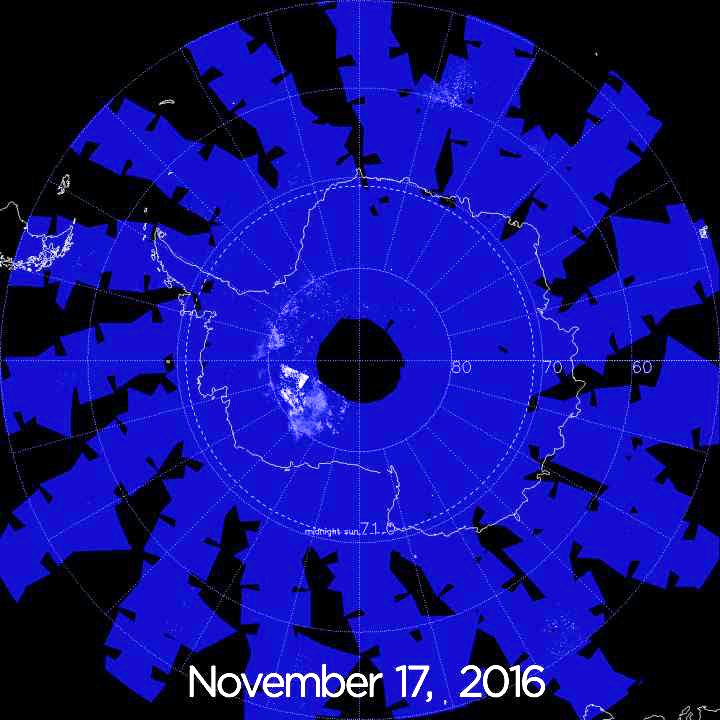NASA's AIM observes early noctilucent ice clouds over Antarctica

Data from NASA's Aeronomy of Ice in the Mesosphere, or AIM, spacecraft shows the sky over Antarctica is glowing electric blue due to the start of noctilucent, or night-shining, cloud season in the Southern Hemisphere. This data was collected from Nov. 17-28, 2016. Credit: NASA/HU/VT/CU-LASP/AIM/Joy Ng, producer
AIM studies noctilucent clouds in order to better understand the mesosphere, and its connections to other parts of the atmosphere, weather and climate. We observe them seasonally, during summer in both the Northern and Southern hemispheres.
This is when the mesosphere is most humid, with water vapor wafting up from lower altitudes. Additionally, this is also when the mesosphere is the coldest place on Earth – dropping as low as minus 210 degrees Fahrenheit – due to seasonal air flow patterns.
This year, AIM saw the start of noctilucent cloud season on Nov. 17, 2016 – tying with the earliest start yet in the AIM record of the Southern Hemisphere. Scientists say this corresponds to an earlier seasonal change at lower altitudes.
Winter to summer changes in the Antarctic lower atmosphere sparked a complex series of responses throughout the atmosphere – one of which is an earlier noctilucent cloud season. In the Southern Hemisphere, AIM has observed seasons beginning anywhere from Nov. 17 to Dec. 16.
Since its 2007 launch, AIM data has shown us that changes in one region of the atmosphere can effect responses in another distinct, and sometimes distant, region.
Scientists call these relationships atmospheric teleconnections. Now, due to natural precession, the spacecraft's orbit is evolving, allowing the measurement of atmospheric gravity waves that could be contributing to the teleconnections.
###
AIM is a NASA-funded mission managed by NASA's Goddard Space Flight Center in Greenbelt, Maryland, and led by the AIM principal investigator from the Center for Atmospheric Sciences at Hampton University in Hampton, Virginia.
Media Contact
All latest news from the category: Earth Sciences
Earth Sciences (also referred to as Geosciences), which deals with basic issues surrounding our planet, plays a vital role in the area of energy and raw materials supply.
Earth Sciences comprises subjects such as geology, geography, geological informatics, paleontology, mineralogy, petrography, crystallography, geophysics, geodesy, glaciology, cartography, photogrammetry, meteorology and seismology, early-warning systems, earthquake research and polar research.
Newest articles

“Nanostitches” enable lighter and tougher composite materials
In research that may lead to next-generation airplanes and spacecraft, MIT engineers used carbon nanotubes to prevent cracking in multilayered composites. To save on fuel and reduce aircraft emissions, engineers…

Trash to treasure
Researchers turn metal waste into catalyst for hydrogen. Scientists have found a way to transform metal waste into a highly efficient catalyst to make hydrogen from water, a discovery that…

Real-time detection of infectious disease viruses
… by searching for molecular fingerprinting. A research team consisting of Professor Kyoung-Duck Park and Taeyoung Moon and Huitae Joo, PhD candidates, from the Department of Physics at Pohang University…




















